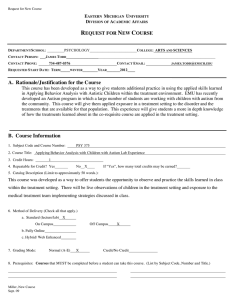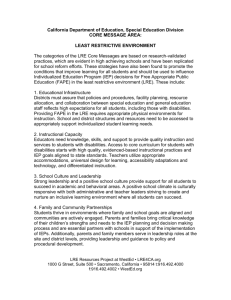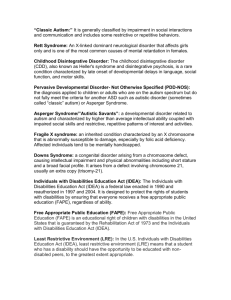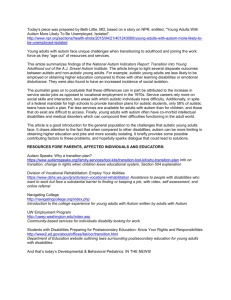SPECIAL EDUCATION PLAN
advertisement
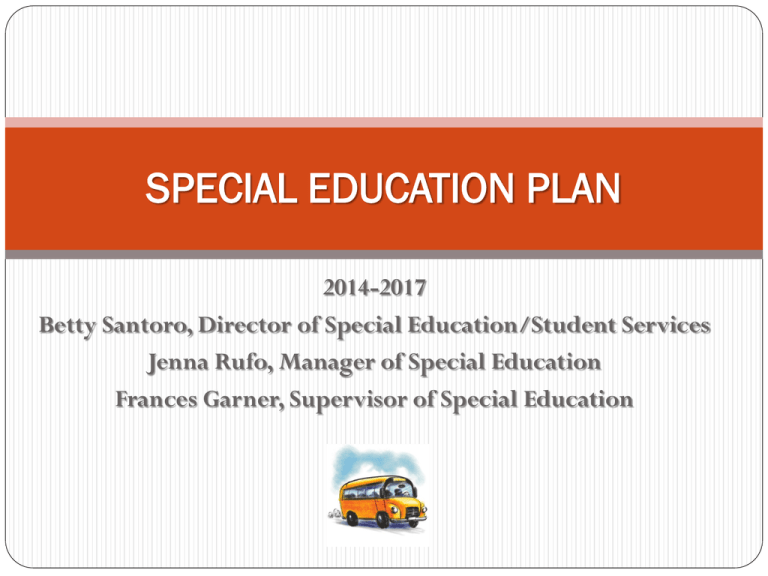
SPECIAL EDUCATION PLAN 2014-2017 Betty Santoro, Director of Special Education/Student Services Jenna Rufo, Manager of Special Education Frances Garner, Supervisor of Special Education CONTENTS OF THE PLAN Penn Data for the 2012-2013 School Year NPSD Program Profile Strengths and Highlights Least Restrictive Environment Behavior Support Services Special Education Personnel Development 1. 2. 3. 4. 5. Autism Behavior Support Paraprofessional Reading NCLB #1 Transition HISTORICAL VIEW OF SPECIAL EDUCATION In 1961, President Kennedy created the President’s Panel on Mental Retardation (federal aide to states) In 1965, President Johnson signed the Elementary and Secondary Education Act (expanded access to public education for students with disabilities) By the early 70’s, still only a small number of students with disabilities were being educated in public schools. In 1975, two federal laws were enacted: 1. The Education for All Handicapped Children Act (EHA)- “right to public education for all children regardless of disability” 2. The Individuals with Disabilities Act (IDEA) requires states to ensure that ALL eligible children with disabilities receive a Free and Appropriate Public Education (FAPE) 3. IDEA (2004) reauthorization of law to strengthen timely identification of students, use of researched based interventions, and transition from HS to college/work. Schools must provide specialized services to address educational needs in the Least Restrictive Environment (LRE) -students must be educated with their non-disabled peers to the maximum extent appropriate -state and federal laws require IEP teams to consider general education classroom setting, with supplementary aids & services, before considering more restrictive placements PENN DATA REPORT ENROLLMENT (SCHOOL AGE) DECEMBER 1, 2012 CHILD COUNT LEA STATE Total Enrollment Total Spec. Ed. Enrollment Percent Spec. Ed. Percent of Spec. Ed. Enrollment by Disability Autism Deaf-Blindness Emotional Disturbance Hearing Impairment Including Deafness Intellectual Disability (MR) Multiple Disabilities Orthopedic Impairment Other Health Impairment Specific Learning Disability Speech and Language Impairment Traumatic Brain Injury Visual Impairment Including Blindness 13,096 2,145 16.4% 1,760,233 268,640 15.3% 11.3% -----6.2% 0.8% 4.2% ----------13.3% 44.5% 18.6% ------------- 8.6% 0.0 8.6% 1.0% 7.1% 1.1% 0.3% 11.2% 45.4% 16.0% 0.2% 0.4% 2013-2014 NP SPECIAL EDUCATION PROGRAM PROFILE LEARNING SUPPORT EMOTIONAL SUPPORT AUTISTIC SUPPORT LIFE SKILLS MDS ELEMENTARY 36 4 17 2 MIDDLE 30 2 4 1 1 HIGH 1 Full Time 24 4 2 1 1 NB 3.5 STRENGTHS AND HIGHLIGHTS Philosophy of Inclusion Specialized Programming Full Continuum of Services Intensive Training in Behavior Mgmt. and Research-Based Interventions Transition Programming LEAST RESTRICTIVE ENVIRONMENT District-wide focus on Inclusion Penn Data Review Methods of Increasing Inclusion 1. Membership, Participation, and Learning (Elementary) 2. Staff training 3. Shift of scheduling 4. Co-teaching LRE District wide practices Gwyn-Nor Inglewood (all students fully included as of Sept. 2013) Penndale Middle School NPHS Multiple Disabilities Support Supports students with multiple learning and health needs Focus on maximizing independence and Activities of Daily Living Augmentative communication devices Allows students to be served within their communities LRE TRENDS 2012-2013 2013-2014 LRE Data Trends 100.0 90.0 80.0 78.2 70.0 66.1 60.0 79.0 76.2 65.9 2012 50.0 2013 40.0 30.0 36.6 20.0 10.0 0.0 Elementary Middle High BEHAVIOR SUPPORTS Committed to supporting students with ED and AS in the least restrictive environment. Full continuum of services ED program at Penndale established in fall 2013 ED program at HS is varied: Itinerant level and/or Grad Mentorship Full time class for Anxiety and Depression School Based Behavioral Health Services NHS Student Assistance Program (SAP) Lakeside Mental Health Counselor PROFESSIONAL DEVELOPMENT 2014-2017 PDE requires five areas of professional development to be addressed: Autism Behavior Support Paraprofessional Reading NCLB Transition AUTISM Needs assessment/survey sent to all professionals in December 2013 Approximately 225 professionals responded Results yielded five areas of top priority to be addressed: 1. Behavior 2. Social Skills 3. Academics 4. Role of Professionals 5. Assistive Technology AUTISM Profile of Students with Autism: Strategies to Support Autistic Students in the Regular Ed. Setting (Regular Education Teachers) Core Instruction in Math/Reading: Taking a Closer Look at the Programs Used in Regular Education (Autistic Support Teachers) Overview of Functional Behavior Assessments, PBSP’s, and Fidelity (Regular and Special Education Teachers) Teaching Social Skills Across All Settings (Regular and Special Education Teachers) Assistive Technology: The What, Why, and When ((Regular and Special Education Teachers) SPA TRAINING Four district staff members (including one spec. ed. admin.) will be recertified yearly by certified Devereux staff to provide training/certification to district staff Staff members already trained will receive (1) day of recertification New staff or staff whose employment requires SPA training will be trained/certified in a (2) day session All nurses will receive ½ day training in order to assess the well being of staff/students following a personal emergency intervention (restraint) School security will receive full day training Extended School Year receive (1) day training prior to ESY sessions Building administrators will receive training along with mandatory reporting of restraints PARAPROFESSIONALS Required 20 hours per year of professional development North Penn provides the training North Penn hosted the paraprofessional Training Fair Each year we offer a variety of meaningful topics that are related to their work. They include the following: Autism training Behavior mgmt. training Strategies to deal with anxiety Strategies to support students transitioning from HS to college Strategies to work with students in reading and math READING Decoding and Encoding Interventions Level 1 55 teachers trained Initial three day training Online course 60 practicum lessons with an individual student 5 observation with trainer Level 2 Group training 50 practicum lessons READING Comprehension Interventions 25 professional development coaching days Six half-day seminars Comprehension and vocabulary development Using data to differentiate instruction Developing independent readers Deepening close reading through text –based questioning Motivating struggling readers Creating and SRI growth plans Elementary special education teachers will receive training in the framework of Leveled Literacy Intervention a research-based strategy based on a systematic instructional design focused on comprehension Continued training of the PA Core for ELA at the elementary level Tiered reading intervention (Grade 7) TRANSITION Indicator 13 training began in the fall of 2013 for secondary teachers Job Exploration Job Training Career/Work Study Travel Training Post 12 Classes Professional Development NOTE FROM A FORMER STUDENT… Dear (Teachers), How are you? I hope you are doing well. First of all, I would like to say thank you for what you have done for me. Today, I got a full time job. I am going to start working as a full time employee on Tuesday January 29 from 10-4 five days a week. I am so excited about this opportunity. This is something!!!!!! I hope you have a good day. I am thinking about you. - STUDENT QUESTIONS


